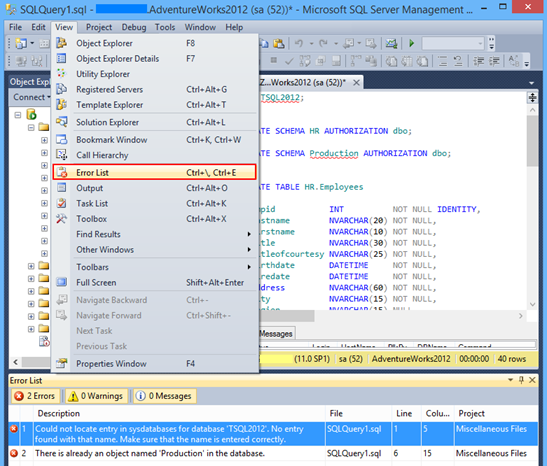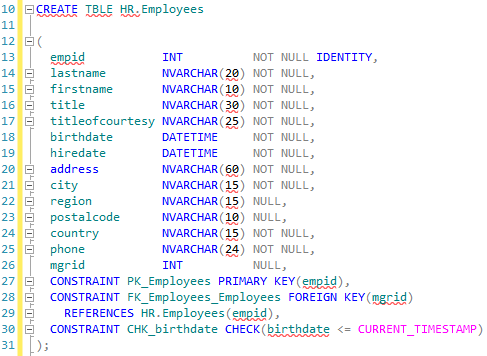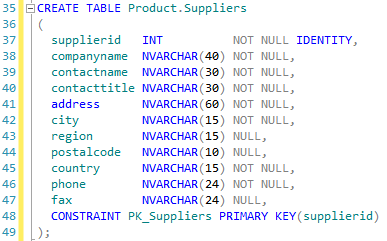
The Error List pane displays syntax and semantic errors found in the query editor. To navigate directly to the SQL syntax error in the script editor, double-click the corresponding error displayed in the Error List
SQL Keyword errors
SQL keyword errors occur when one of the words that the SQL query language reserves for its commands and clauses is misspelled. For example, writing “UPDTE” instead of “UPDATE” will produce this type of error
In this example, the keyword “TABLE” is misspelled:


As shown in the image above, not only the word “TBLE” is highlighted, but also the words around it. The image below shows that this simple mistake causes many highlighted words
In fact, there are total of 49 errors reported just because one keyword is misspelled

If the user wants to resolve all these reported errors, without finding the original one, what started as a simple typo, becomes a much bigger problem
It’s also possible that all SQL keywords are spelled correctly, but their arrangement is not in the correct order. For example, the statement “FROM Table_1 SELECT *” will report an SQL syntax error

Arrangement of commands
The wrong arrangement of keywords will certainly cause an error, but wrongly arranged commands may also be an issue
If the user, for example, is trying to create a new schema into an existing database, but first wants to check if there is already a schema with the same name, he would write the following command

However, even though each command is properly written, and is able to run separately without errors, in this form it results in an error

As the error message states, CREATE SCHEMA command has to be the first command that is given. The correct way of running this commands together looks like this

Using quotation marks
Another common error that occurs when writing SQL project is to use double quotation marks instead of single ones. Single quotation marks are used to delimit strings. For example, double quotation marks are used here instead of single ones, which cause an error


Replacing quotation marks with the proper ones, resolves the error

There are situations where double quotation marks need to be used, for writing some general quotes, for example

As shown in the previous example, this will cause an error. But, this doesn’t mean that double quotes can’t be used, they just have to be inside the single quotes. However, adding single quotes in this example won’t solve the problem, but it will cause another one

Since there is an apostrophe inside this quote, it is mistakenly used as the end of a string. Everything beyond is considered to be an error

To be able to use an apostrophe inside a string, it has to be “escaped”, so that it is not considered as a string delimiter. To “escape” an apostrophe, another apostrophe has to be used next to it, as it is shown below

Finding SQL syntax errors
Finding SQL syntax errors can be complicated, but there are some tips on how to make it a bit easier. Using the aforementioned Error List helps in a great way. It allows the user to check for errors while still writing the project, and avoid later searching through thousands lines of code
Another way to help, is to properly format the code

This can improve code readability, thus making the search for errors easier

- Using custom reports to improve performance reporting in SQL Server 2014 – running and modifying the reports - September 12, 2014
- Using custom reports to improve performance reporting in SQL Server 2014 – the basics - September 8, 2014
- Performance Dashboard Reports in SQL Server 2014 - July 29, 2014
